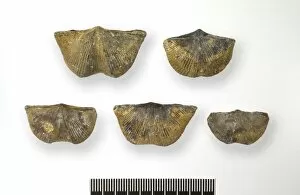Brachiopoda Collection
"Exploring the Fascinating World of Brachiopoda: From Lingula sp
All Professionally Made to Order for Quick Shipping
"Exploring the Fascinating World of Brachiopoda: From Lingula sp. To Mucrospirifer" Brachiopods, an ancient group of marine invertebrates, have captivated scientists and fossil enthusiasts for centuries. Among them, the Lingula sp. Brachiopod stands out with its delicate shell and remarkable ability to burrow into soft sediments. One cannot overlook the beauty of Mucrospirifer, a fossil brachiopod that showcases intricate spiral patterns on its shell. These fossils provide us with a glimpse into prehistoric oceans and remind us of the incredible diversity that once existed. Fossil stone swallow brachiopods C016 / 5992 take us back even further in time, allowing us to witness these creatures from millions of years ago. Sinospirifer sp. , also known as Shih-yen stone swallow brachiopods, adds another layer to this story with their unique appearance and cultural significance. Intriguingly, some brachiopods are mounted alongside Chinese medicinal recipes. This fusion between science and traditional medicine highlights their potential therapeutic properties throughout history. Roman lamp adorned with a fossil brachiopod serves as a testament to how these organisms were valued even in ancient times. The combination of artistry and natural history creates an exquisite piece that tells tales from both past eras. Cyrtospirifer verneuili (Murchison), Delabole butterfly brach is yet another example showcasing the diverse forms within this phylum. Its delicate wingspan-like shape evokes images of ethereal butterflies fluttering through primordial seas. Spiriferina takes center stage as one of the most recognizable fossilized brachiopods due to its distinctive ribbed shell structure. Its presence in geological formations provides valuable insights into Earth's evolution over millions of years.



















